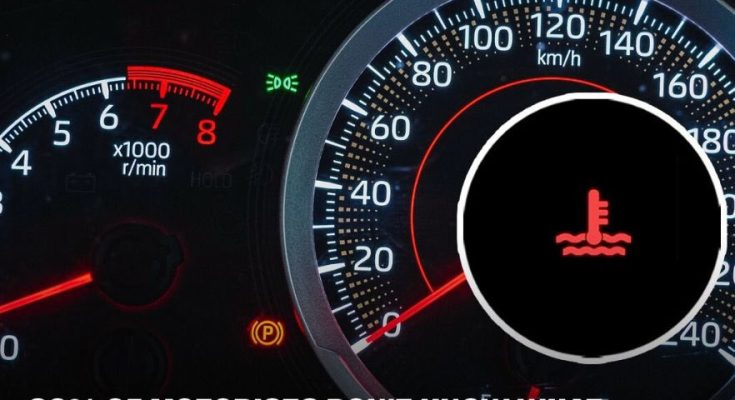Let’s be honest—dashboard warning lights can feel like a foreign language. With so many icons lighting up your car’s dashboard, it’s easy to get confused, especially when one appears that you don’t recognize. Among these puzzling symbols, there’s one that has baffled drivers for decades. Many jokingly describe it as looking like a “boat,” but this quirky symbol carries an important warning. Knowing what it means could save your engine from serious damage—and save you thousands in repair costs.
What Does the “Boat-Like” Dashboard Symbol Actually Mean?

This mysterious dashboard light is officially known as the engine coolant temperature warning light, and no, it has nothing to do with boats or water travel. The icon, which resembles a thermometer hovering above wavy lines, is your car’s way of alerting you to an issue with its cooling system.
This warning light signals that your engine is either overheating or experiencing a coolant-related problem. Essentially, it’s your engine’s distress signal, letting you know it’s running too hot. Ignoring this light can lead to catastrophic consequences, such as warped engine parts, cracked cylinder heads, or even complete engine failure.
Most Drivers Don’t Recognize This Crucial Warning
A recent survey by ATS Euro master uncovered a shocking fact: 80% of drivers don’t know what this dashboard symbol means. That’s a huge number of people who could unknowingly put their engines at risk.
The confusion has become so widespread that social media users have turned it into a joke. A viral post on X (formerly Twitter) featured a picture of the light with the caption, “What does this even mean?” Responses ranged from comical guesses like, “Time to set sail!” to incorrect advice such as, “Your engine isn’t warmed up yet.” Unfortunately, none of these answers hit the mark.
The reality is simple: when this light appears, it means your engine’s cooling system is compromised, and immediate action is required to prevent serious damage.
What to Do When the Coolant Warning Light Comes On
Seeing the coolant warning light might feel alarming, but staying calm and taking the right steps can make all the difference. Here’s what you should do:
- Pull Over Immediately
The moment you see the light, find a safe spot to pull over and turn off your engine. Continuing to drive with an overheating engine can cause irreversible damage within minutes. - Let Your Engine Cool
Don’t pop the hood right away. Hot coolant is under high pressure and can cause burns if you open the reservoir cap too soon. Wait at least 30 minutes to allow the engine to cool completely. - Check the Coolant Levels
Once the engine has cooled, inspect the coolant reservoir. Most cars have a transparent coolant tank with minimum and maximum markers. If the coolant level is low, carefully top it off with the manufacturer-recommended coolant. - Look for Signs of a Problem
If topping off the coolant doesn’t fix the issue, inspect your engine for signs of trouble. Common indicators include puddles of coolant under the car, hissing noises, or a sweet smell—an indicator of a coolant leak. - Call for Professional Assistance
If you’re unsure what’s causing the issue or don’t feel confident performing these checks, call a trusted mechanic or roadside assistance. Driving with an unresolved cooling system issue isn’t worth the risk.

Common Causes of Coolant System Issues
While low coolant levels are the most common reason for this warning light, other underlying issues could trigger it. Here are some possible culprits:
- Coolant Leaks: Cracks in hoses, a damaged radiator, or a faulty gasket can lead to coolant escaping from the system.
- Faulty Thermostat: A malfunctioning thermostat may block the flow of coolant, causing the engine to overheat.
- Water Pump Problems: The water pump is crucial for circulating coolant. If it’s failing, the engine temperature will quickly rise.
- Radiator Issues: A clogged or leaking radiator can disrupt the cooling process, leading to overheating.
- Sensor Malfunctions: Sometimes, the warning light may appear due to a faulty temperature sensor, even if the system is functioning correctly.

How to Prevent the Coolant Warning Light from Coming On
The best way to avoid seeing this dreaded light is to stay on top of routine maintenance. Here are a few simple steps to keep your cooling system in good condition:
- Regularly Check Coolant Levels: Monitor your coolant levels every few weeks and top off as needed.
- Inspect Hoses and Connections: Look for signs of wear, cracks, or leaks in the coolant hoses and connections.
- Flush the Cooling System: Over time, coolant can become contaminated. Follow your car’s maintenance schedule to flush and replace the coolant.
- Check Your Radiator: Keep the radiator free of debris and inspect it regularly for signs of corrosion or leaks.
- Listen to Your Car: Pay attention to unusual smells or noises. A sweet smell, in particular, could indicate a coolant leak.
By staying proactive, you can prevent most cooling system issues and avoid the stress of an overheating engine.
The Cost of Ignoring the Warning Light
Ignoring the engine coolant temperature warning light can lead to serious consequences, both mechanical and financial. If the engine overheats, it can cause damage to essential components like the head gasket, pistons, and cylinders. Repair costs for such issues can range from $1,000 to $5,000 or more, depending on the extent of the damage. In some cases, the damage may be so severe that replacing the entire engine becomes necessary.
Taking immediate action when you see the light can save you from these costly repairs and extend the life of your vehicle.

Why Understanding Dashboard Symbols Matters
Your car’s dashboard is its way of communicating with you, and each symbol serves a purpose. Learning to recognize and respond to these warning lights isn’t just about protecting your car—it’s about ensuring your safety and the safety of your passengers. The more familiar you are with your dashboard’s icons, the better equipped you’ll be to handle any situation on the road.
Conclusion: Don’t Ignore the “Boat-Like” Symbol
The dashboard light that “looks like a boat” might seem puzzling at first, but now you know its true meaning—and its importance. It’s not nautical at all; it’s a thermometer over wavy lines, signaling an issue with your car’s cooling system. When this light appears, don’t dismiss it. Pull over, let the engine cool, check your coolant levels, and seek professional help if needed.
By understanding what this symbol represents and taking the right actions, you can protect your engine, save on costly repairs, and drive with peace of mind. The next time this light appears, you won’t be left scratching your head—you’ll know exactly what to do.



